REMEMBERING M. MANIAM
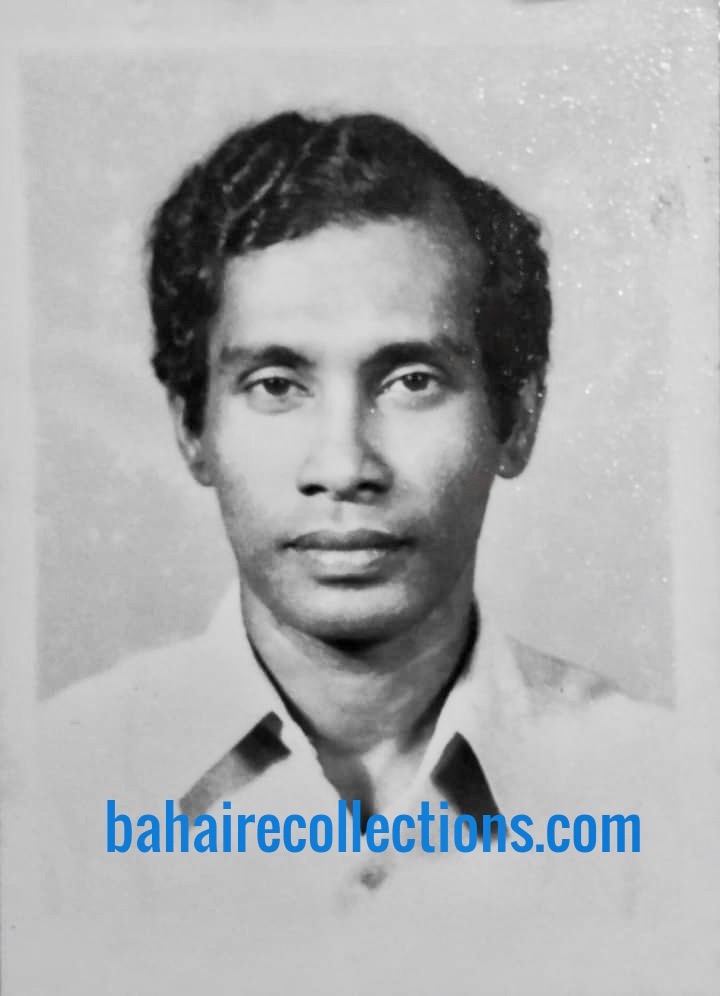
5 December 1937 to 10 July 2008
The Universal House of Justice was saddened to learn from email letter of 10 July 2008 of the passing of Maniam Muthaiah a steadfast servant of the Blessed Beauty. His devoted services as a member of the National Spiritual Assembly of Malaysia and as a pioneer to Sarawak for over four decades are remembered with loving appreciation.
With Loving Bahá’í Greetings
Department of the Secretariat
Universal House of Justice
Mr. Maniam Muthiah or affectionately called “Penghulu Maniam” was one of the great teachers of our Faith during the formative period of the Faith in Malaysia. Accepting the Faith during the Ten-Year Crusade period, he arose with such boundless enthusiasm and zeal to serve the Cause until his last days. Immediately after accepting the Faith, he became a full-time teacher and dedicated his whole life to the Cause, and happily embraced death with his boots on as a pioneer in his chosen land.
Maniam along with his classmate Jami Subramaniam, associated with the believers of Malacca town since early 1957 while still church-going students when studying at the Methodist English School. These two were about to be baptized after being exposed to Christianity. But it was just then that the Healing Message of Bahá’u’lláh wafted over them. Both started to investigate the Faith and soon accepted the Faith in 1957. They were deepened by Mr. Leong Tat Chee and Mr. Saurajen, the two early believers of the Malacca town community. Upon accepting the Faith, Maniam was actively involved in the local Bahá’í activities.
After his studies, Maniam was looking after his family business in managing a sundry shop and involved in part-time gardening work. Keenly involved in the activities in Malacca, Maniam rose as one of the strongest pillars of the Faith. Maniam had a very good understanding of the Cause of Bahá’u’lláh, in the early days of his acceptance of the Faith through some rare experiences and exposures that were well enjoyed only by the first batch of believers in the country. One was attaining the presence of the Hands of the Cause of God and basking under their talks that moved the hearts.
It was at the first summer school held in December 1957 in Malacca that Maniam attained the presence of the Hand of the Cause of God Dr. Rahmatu’lláh Muhájir, and he continued to enjoy the bounty of attaining his presence in many of Dr. Muhájir’s return visits to Malaya. And at the Third Pan-Malayan Teaching Conference held in February 1961 in Malacca, Maniam attained the presence of Hand of the Cause of God Ṭaráẓu’lláh Samandarí. He attained the presence of Hands of the Cause of God Mr. Abu’l-Qásim Faizi and Miss Agnes Alexander in early October 1958 when they came together to grace the wedding of Tony Fernandez and Betty. Maniam also attained the presence of Amatu’l-Bahá Rúhíyyih Khánum when she first visited Malaya in 1961 and later in 1964 when she came for the first national Bahá’í convention in Kuala Lumpur. At the election of the first National Spiritual Assembly of East Malaysia in 1972, he attained the presence of the Hand of the Cause Mr. Jalal Khazeh which happened to be his only visit to this country. In his talks, Maniam used to quote the advice and words of guidance uttered by these highly distinguished Hands.
Yet another event that enabled Maniam to gain a deep understanding of the Cause was the impactful Sunday Classes that Mr. Kumara Das, Mr. Anthony Louis, and Mr. Saurajen conducted in 1958 for the Bahá’í youths in the Malacca High School. Those classes were held to activate the first batch of youth that had accepted the Faith. The Sunday Classes deepened some of the best known and most abled believers such as Jami Subramaniam, Leong Ho San, Errol Seow Hoon Hin, Purushothman Nair, and Maniam who would in the years ahead go on to serve the Cause most devotedly, after being well-grounded in the basics of the Faith.

A gathering of adults and youth at the Boy Scout Headquarters, circa 1958. Kumara Das is in the middle with a black necktie. Anthony Louis is squatting at the extreme right. Koh Ai Leen is standing at the extreme right. Lily is standing third from right, Raymond Peter stands eighth from the right with sunglasses. Leong Ho San is standing fifth from left, with M. Maniam standing in front of him. The three squatting from left are Pijush Kanti Paul, Tushar Kanti-Paul, and Jami Subramaniam
In 1961, Maniam was appointed on the “Watch Committee” under the Local Spiritual Assembly of Malacca town. The function of this Watch Committee was to assist in the consolidation of the community, especially in bringing back to the fold those dormant Bahá’ís who had not been attending Nineteen Day Feasts and fireside meetings for a long time. The Local Spiritual Assembly had prepared a list of such dormant believers and Maniam and a few others visited them and did succeed in winning them over.
In 1962, Maniam was tasked with undertaking single-handed trips to the rubber plantation settlements in the state of Malacca. The Local Spiritual Assembly of Malacca town sent Maniam to these rural areas to consolidate the many people who had come into the Faith in large numbers. In one of those trips, Maniam was caught in a very tricky and uncomfortable situation. In one rubber plantation settlement, the labourers were going to strike for not being paid enough wages. This posed the Local Spiritual Assembly a delicate dilemma as some labourers were followers of the Bahá’í Faith as well. The Assembly conveyed to Maniam to get the believers out of these strikes. Maniam traded only too well in the deep waters and came out triumphant in dissuading the believers from going on strike. When the strikes were called off, the estate management observed that the followers of the Bahá’í Faith among the labourers had kept away from the strikes, and the estate management rewarded the Bahá’í workers who kept away from the strike. When the Local Spiritual Assembly came to know of this, the institution appreciated Maniam for carrying out the delicate task with success.
Throughout 1962, Maniam was somewhat a full-time teacher of the Faith and involved in teaching activities in the rural areas. At one particular moment, Maniam ran short of money and was subsisting by visiting the coffee shops in that area and surviving by eating bread crusts alone. Maniam did not inform the Local Spiritual Assembly. Yet this poignant news reached the Local Spiritual Assembly which found it was not possible to get the necessary funds to be sent in time to Maniam immediately. The always generous-hearted Raymond Peter rushed to his grocery shop in Jasin town and bought some provisions on credit. Next, Peter took his radio to another shop and sold it at less than half the price and with the money bought more provisions and sent them over to Maniam. Maniam related this incident to many friends and to his family till his last days. Peter was always fond of Maniam for being a good fieldworker and a committed servant of Bahá’u’lláh and kept in touch with him all his life.
The year 1963 became a turning point for Maniam. While the Cause was progressing reasonably well in Peninsula Malaya, there was a need for abundant manpower to toil for the Cause in the Borneo territories. The Regional Spiritual Assembly of Southeast Asia decided to send three believers to the Borneo territories – Yankee Leong and Maniam from Malaya and Abolfazl Bijan Bayzaee, a travel teacher from Iran.
Bayzaee arrived in December 1962 in Bangkok and came over to Singapore, waiting for instructions from the Regional Spiritual Assembly on his posting. Mrs. Shirin Fozdar was on her way to Jakarta for the meeting of the Regional Spiritual Assembly where Hand of the Cause of God Dr. Muhájir was to be present. Bayzaee wrote a letter to him through Mrs. Shirin Fozdar, and in the letter, he had indicated his willingness to serve in any part of the region. Meanwhile, Bayzaee travelled around Port Dickson, Seremban, Kuala Lumpur, and Alor Star. It was while he was in Seremban that news came that the Regional Spiritual Assembly had decided to send him, Yankee Leong, and Maniam to the Borneo state of Sarawak. Yankee Leong had already been to Sarawak in 1960 and was quite familiar with the conditions there. Raymond Peter, the big-hearted believer from Malacca always had a great liking for Maniam, and the moment he heard that Maniam was going to Borneo Islands, Peter being a Health Inspector knew of the prevalent malarial disease in the interiors, spread by mosquitoes, and so he gave Maniam a blanket and a mosquito net that is still kept by the family to this day.
From Malaya, the three arrived in the house of Mrs. George Lee in Singapore and bought some important needs to be taken with them. From there they took a cargo boat and arrived in Kuching after three days of sea journey and stayed in a modest hotel. In Kuching, Yankee Leong met a Chinese friend who arranged dinner and fireside where the former spoke on the Faith. Their next stop was Sibu where they attempted to teach the Chinese people there. There they met Mr. Chi Chia Qui and his wife Mei Si Chi who were among the first batch of believers in Kuching. Mr. Chi Chia Qui served as the Vice Chairman of the first Local Spiritual Assembly of Kuching in 1953 during Jamshed Fozdar’s time.
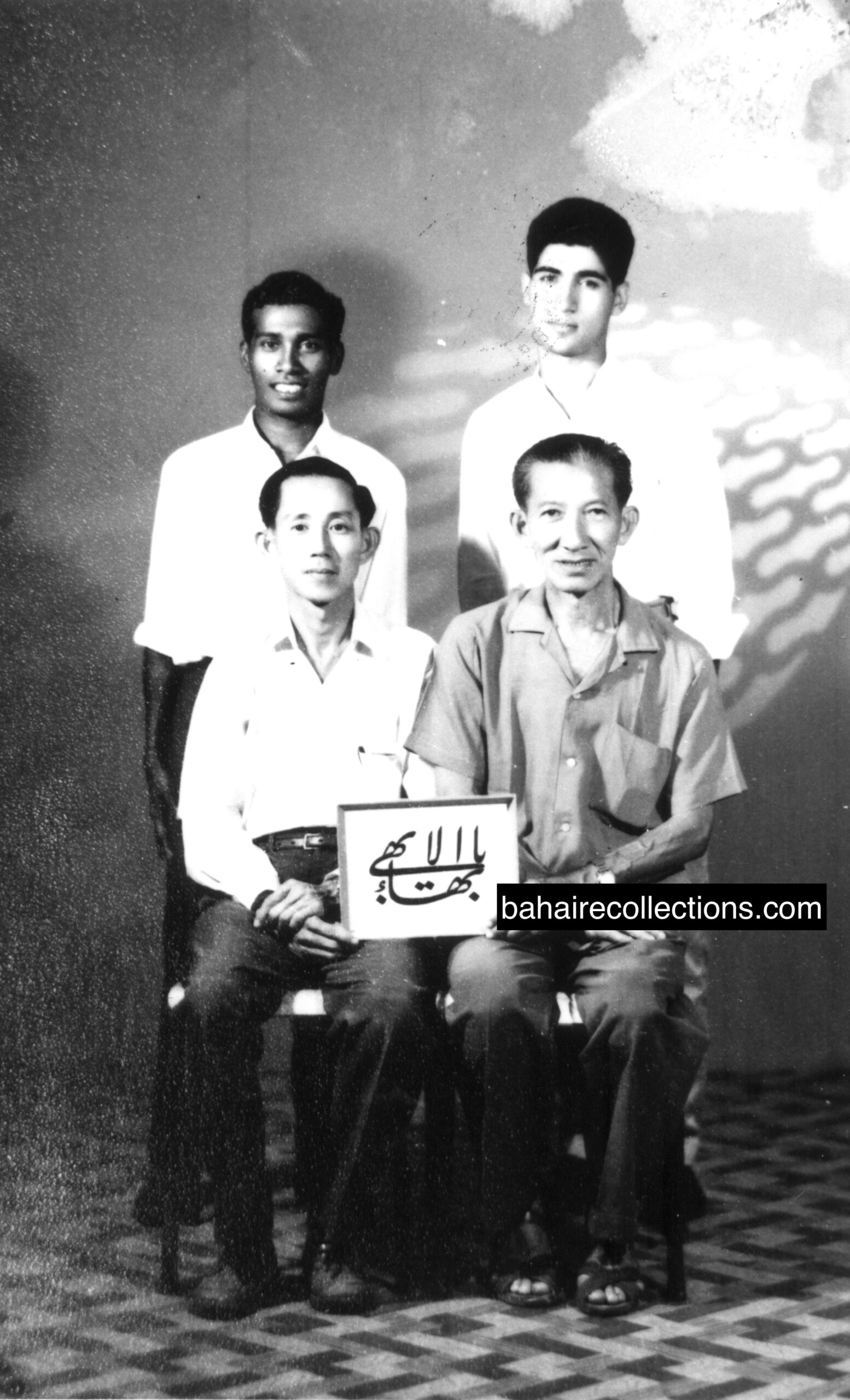
March 1963. Standing Maniam at left and Bayzaee at right. Sitting L-R: Mr. Mr Ong Chuan Choon and Yankee Leong. Mr Ong Chuan Choon was the first Bahá’í of Kanowit and a headmaster there. He was originally from Sibu.
Their next stop was Kapit town where the three established their base. They first stayed on the first floor of a shophouse belonging to a Chinese man, who sold jewelry and rubber sheets on the ground floor. Yankee Leong was their guide and mentor on how to present the Faith to the Iban people (native people of Sarawak) in the longhouses and gave them all the words of encouragement for the wonderful services they were rendering the Cause. He would on occasions have told Maniam and Bayzaee what instructions he had received from Dr. Muhájir.
Bayzaee recalls what he witnessed as he and Maniam arrived in Kapit. The infrastructure was still at an infant stage, with only the Government Rest House as the only visible building. Public transport was unheard of or very rare. Roads in the town were almost empty. Rivers had to be crossed by boats and ferries. Life was difficult, but the love for the Cause and the trust the Regional Spiritual Assembly of South East Asia had in them were the propelling forces for them to soldier on.
The three were very successful in their very first visit to the longhouse in the most remote locality of Sepulau along Sungai Gaat in Kapit district. lt would take about a full day journey by longboat from Kapit to reach that remote area where he was able to establish the Faith. Yankee Leong would make the presentation of the Faith in the evenings when all the families in the longhouses had returned from farming and hunting. After dinner, they all gathered at the common meeting ground and Yankee Leong would introduce Maniam and Bayzaee, saying that they were from Indian, Persian, and Chinese backgrounds but united in one common Faith whose membership comprises a microcosm of the entire race throughout the world and that they were inviting the Ibans to join in this world fellowship of unity in diversity. As Yankee Leong would continue his presentation, Maniam and Bayzaee would distribute brochures and photos of the Bahá’í gatherings throughout the world published in the Bahá’í News magazine published by the National Spiritual Assembly of the Bahá’ís of United States. They succeeded in enrolling no less than a thousand new believers. After mid-1963 Maniam and Bayzaee established cordial relationships with one Penghulu Kumbong who was the powerhouse of Bahá’í activities in Kapit. Association with Penghulu Kumbong further enhanced the activities in the area.
In Kapit town too they were involved in robust teaching activities and opened new areas for the Faith. Three foreigners serving in the Kapit Electric Company came into the Faith- Mr. George Walter, Mr. Edward Bahoe, and Mr. Asong. They could speak some Iban language and helped the three to purchase a boat and an engine for travelling and visiting the Bahá’í longhouses for the consolidation works. They named the boat “The Dawn-Breakers”. They also were recipients of two American travelling teachers who accompanied them during their consolidation visits in the longhouses – Ms. Delores Margaret Thomas and Mr. Earl Mock.
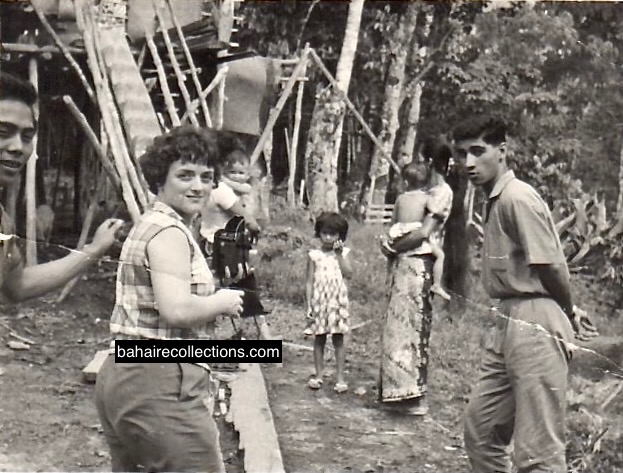
Ms. Delores Margaret Thomas and Bayzaee
While in Kapit, Bayzaee produced the Arabic version of the Greatest Name in the fashion standardized by the famous calligrapher Jináb-i-Mishkin Qalam on a 3×5 feet board. Both Maniam and Bayzaee never missed out on any opportunity to teach the Cause. There was a time when Bayzaee was admitted into the Christian Missionary Hospital that was run by the Seventh Day Adventist denomination. Bayzaee presented his doctor with the book “Christ and Bahá’u’lláh”.
Maniam wrote a report to the Regional Spiritual Assembly of South East Asia, which was published in its newsletter Bahá’í News for April 1963. Maniam wrote, “On 28 March, we crossed the river opposite Kapit and walked about six miles before reaching the houses where we found a few people. The rest of them were in the fields. We planted the seed of Bahá’u’lláh in their hearts and they have invited us again. Throughout the journey to this home, we walked in mud, bushes, over hills, and in the river. We fell, hurt, and bled before reaching the house. On 29 March we sailed with Mr. Walter to a different area and reached a longhouse. Here we found only one soul as the rest were in the fields.”
The Bahá’í News for April 1963, also proudly reported the great services of Yankee Leong, Maniam, and Bayzaee in Borneo. Part of the report read, “Mr. Yankee Leong and Mr. Maniam from Malaya and Mr. Bayzaee of Iran spent more than one month in propagating the Faith in Sarawak. They taught in the Third Division of Sarawak and were instrumental in attracting more than 1,000 people to the Faith. The success they encountered has far exceeded their hopes. Heartened, they hope now for an even greater outpouring of Divine Grace to guide many more to the Cause of God.” The same newsletter for April 1963 published that the three were recipients of a most joyful congratulatory message from the Hands of the Cause of God in Haifa.
Yankee Leong returned to Singapore to prepare to attend the First Bahá’í World Congress in London. Maniam and Bayzaee remained in the Kapit district as pioneers to consolidate the teaching work already done. After Yankee Leong had left, Maniam and Bayzaee rented a room in the town.
MANIAM BECOMES “PENGHULU”
Maniam and Bayzaee made frequent visits to the Sungei Gaat area. Here they faced many difficulties in an unknown land, and with people of unknown culture and language. They often slept on the boats, and it did not take long before they started to win over the hearts of the Iban people, who lived in the longhouses. They started to live as one among the Iban people in the longhouses. They even started to partake of their food, especially “kasam” a traditional favorite cuisine of the Iban people, made by fermenting meats, predominantly pork. Maniam especially also dressed in the local costume and danced with them during local festivals. Maniam on his part sang popular songs from the Tamil movies to entertain the Iban people. Once Maniam was able to converse well in the Iban language, he started to teach them the Faith giving all the counsels that Bahá’u’lláh had taught. “Penghulu” is the title given to a community leader in a particular area. It was always customary for the Penghulu to give counsel, guidance, and advice. And it was while serving in Sungai Gaat, that the local Bahá’ís affectionately started to call Maniam “Penghulu” on account of the strong words of guidance and wisdom that Maniam gave from the Writings.
Maniam’s services in Sarawak were truly excellent and came to be recognized even in the international arena. Dr. John Fozdar who became a Knight of Bahá’u’lláh for settling in Brunei attended the first International Convention to elect the Universal House of Justice in 1963. When Dr. John Fozdar went to see Maniam in Sibu where Maniam was staying at the time of that visit, he conveyed to Maniam a firsthand account of the proceedings of that international event. Further, Maniam was very much inspired when Dr. John informed him that the Bahá’ís who had gathered at the Convention had prayed for all the pioneers around the world. That inspired Maniam and served as a catalyst for him to rise to a higher level in the field.
RETURNS TO WEST MALAYSIA
Maniam was in Sarawak for nine months during which time he underwent many hardships. On 16 September 1963 was the formation of Malaysia with the states of Sabah, Sarawak, and Singapore joining Peninsula Malaya as one political entity. There was a big celebration in Kapit, which Maniam and Bayzaee witnessed. The formation of Malaysia sparked off a confrontation between Malaysia and Indonesia. Maniam found that he could not get his visa extended, and the interiors of Sarawak were not safe owing to the confrontation. Therefore, he was forced to return to West Malaysia on 24 October 1963.
As for Bayzaee, his visa for Sarawak was extended twice, but the authorities refused to extend any further. And so Bayzaee traveled to Brunei and stayed with the family of Mr. Minoo Fozdar. For the last three weeks of 1963, Bayzaee stayed with Dr. John Fozdar, a Knight of Bahá’u’lláh, and his family in Sandakan before returning to Laos through Singapore in February 1964.
While Maniam and Bayzaee were in Sarawak they were successful in establishing more than one hundred Local Spiritual Assemblies in Sarawak through their vigorous teaching activities. They had their own challenges and struggles in the field. While Yankee Leong was with them in the early part of 1963, it was Yankee Leong who gave them all the words of encouragement to soldier on. After he had left, the constant string of letters of encouragement from Jamshed Fozdar, Chairman of the Regional Spiritual Assembly of South East Asia and based in Saigon gave them all the needed strength. Jamshed Fozdar was the first to have taught the Faith in Sarawak when he went there in 1951 and the beloved Guardian referred to him as the Spiritual Conqueror of Sarawak. Occasionally, Mr. Kamran Samimi, another member of the Regional Spiritual Assembly of South East Asia too sent them letters of encouragement.
However, his invaluable services in Sarawak were very greatly needed as the vacuum created by his return from Sarawak could not be adequately and immediately filled. Therefore, on behalf of the National Teaching Committee, its members Mr. Inparaju Chinniah or Inbum Chinniah as he was fondly called and Mr. Raymond Peter urged Maniam to return to Sarawak, with the confrontation situation between Indonesia and Sarawak toning down. But for the first time, Maniam spoke his mind and opened the eyes of Peter and Inbum. And that conversation was a turning point for Inbum and Peter. When Peter and Inbum gave all the words of encouragement to Maniam to return to Sarawak, Maniam retorted saying he was not interested in pep talks. Maniam said giving words of encouragement and giving a grand sendoff was the easiest, but what was more important was to monitor and care for the travel teachers and pioneers who were in the interiors. Maniam mentioned for the first time some of the untold sufferings he had undergone in Sarawak. Apparently, on several occasions, he almost drowned in the rivers, and on several other occasions, he either fell seriously sick or ran out of food. Suffering in silence, he never complained to anyone at that time, and his only trust was the helping hand of Bahá’u’lláh. For the first time, he reported this to Peter and Inbum. Having spoken his sufferings, he broke down. Inbum was almost in tears while Peter was very disturbed. It was partly this heated conversation that planted the seeds for Inbum and Peter to serve the Cause abroad. History has it that with the constant encouragement by Hand of the Cause of God Dr. Rahmatu’lláh Muhájir, Peter pioneered to Ceylon from the end of 1969 to mid-1973, while Inbum went to Tanzania for six months at the end of 1972. But the shot was given first by Maniam in that heated conversation between the three in 1963.
But his extensive and rich experiences in Sarawak could not be erased from his soul. Maniam was already a well-grounded field worker in the jungles of Sarawak. When the first national convention for the election of the National Spiritual Assembly of Malaysia was held in Kuala Lumpur in April 1964, Maniam was invited to give a talk on the topic of “Taking the Faith to the minority groups in the Borneo territories”. Hand of the Cause of God Amatu’l-Bahá Rúhíyyih Khánum who was the official representative of the Universal House of Justice at the convention was so impressed with his services in Sarawak that she requested him to excel in that area of service for the Cause.
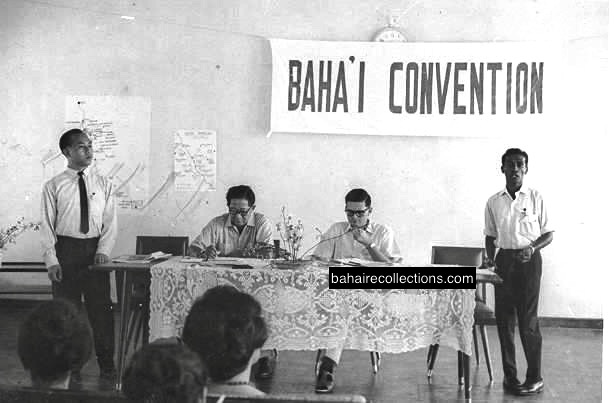
National Bahá’í Convention in Kuala Lumpur, 1964. Maniam, at right, speaks while Phung Woon Khing on left translates. Seated are Leong Tat Chee left and Harlan Lang at right
Meanwhile, Maniam was fully involved in full-time travel teaching in West Malaysia from the time he returned from Sarawak. While Maniam was trying to settle for some path of service in West Malaysia, Dr. R. J. Wolff, a Bahá’í from Hawaii, who had come to study the dietary habits of the aborigine people in Malaysia offered Maniam accommodation at his home in Petaling Jaya. Maniam thus had undertaken visits to the aboriginal villages in the jungles of West Malaysia. To this day he is still remembered by the early Asli believers, especially around Sungkai in Perak state.
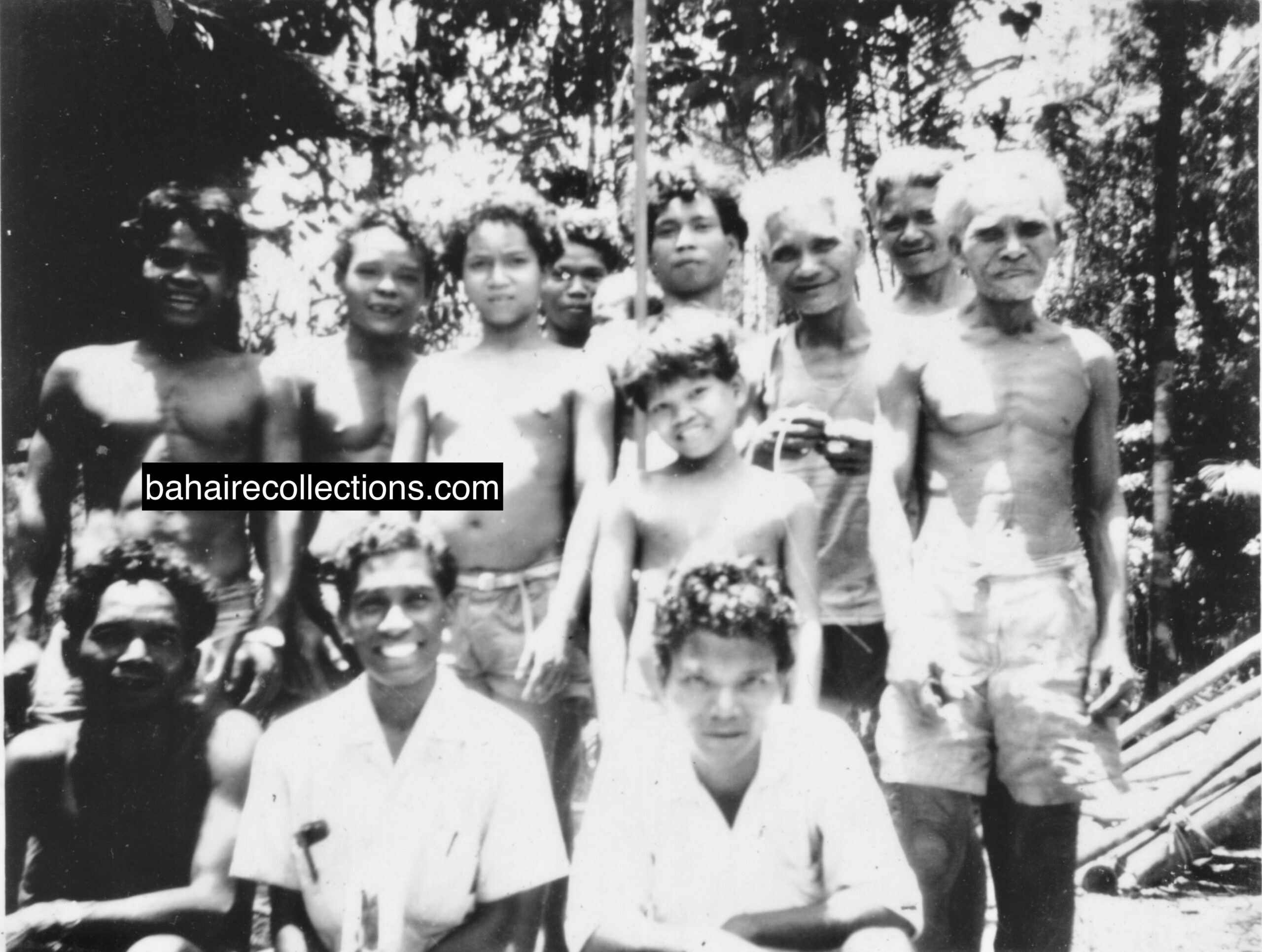 Maniam with the aboriginal friends
Maniam with the aboriginal friends
Maniam then wrote a very moving letter to the National Teaching Committee: “…I am offering myself to the National Teaching Committee and am prepared to accept whatever decisions they may have for me.” The National Teaching Committee was very moved by the sincere tone of that letter. Seeing that Maniam had submitted himself to any path of service, the National Teaching Committee conveyed its loving appreciation for his efforts and sacrifices for the Cause of Bahá’u’lláh and offered him all the assistance in making him a full-time teacher for the Cause in West Malaysia.
For three years he was involved in full-time travel teaching in West Malaysia and attended many Bahá’í gatherings. In 1964, he went to assist in developing the Faith in Kuantan town in the state of Pahang till 1965. The outbreak of cholera in the east coast states of Kelantan, Terengganu, and Pahang in the mid-1960s took Raymond Peter of Malacca to these places where he was successful in eradicating cholera and serving the Cause effectively. When Peter was in Terengganu in 1964, he invited Maniam to stay with him to teach the Faith. It was in June 1965 that the National Spiritual Assembly of Malaysia released the first issue of the Malaysian Bahá’í Magazine. Several regional correspondents were appointed for various parts of Malaysia to send reports. Maniam was one of the regional correspondents for this magazine for the East Coast and wrote comprehensive and moving reports to this magazine which were published in the very first maiden issue.
After serving in Kuantan, Maniam came to serve in the Bagan Serai community in the state of Perak in 1965. Mr. Tony Fernandez and his wife Betty had moved from Malacca to this community in late 1963. While Tony moved in the higher echelon as Assistant Superintendent of Police in the Krian District, and Betty as a teacher moved in the middle-income society, they still needed some field worker to take the Cause to the grassroots. Maniam fitted that role very well and at the same time teamed up very well with them. It was while here that Maniam brought several people into the Faith. Two of the gems were Mr. Thinathayallam Ponnusamy and Mr. Munusamy Nathamuni. These two were studying in the school where Betty taught. Thinathayallam had accepted the Faith through Maniam in the home of Tony Fernandez on 25 December 1965. Munusamy had heard of the Faith through Betty in 1963, but it was Thinathayallam who took Munusamy to the same house where he signed up in the dining hall in 1966. Betty gave Munusamy a prayer book and a copy of the famous Bahá’u’lláh and the New Era book by John Esslemont. Thinathayallam and Munusamy later rose to serve the Cause with distinction.
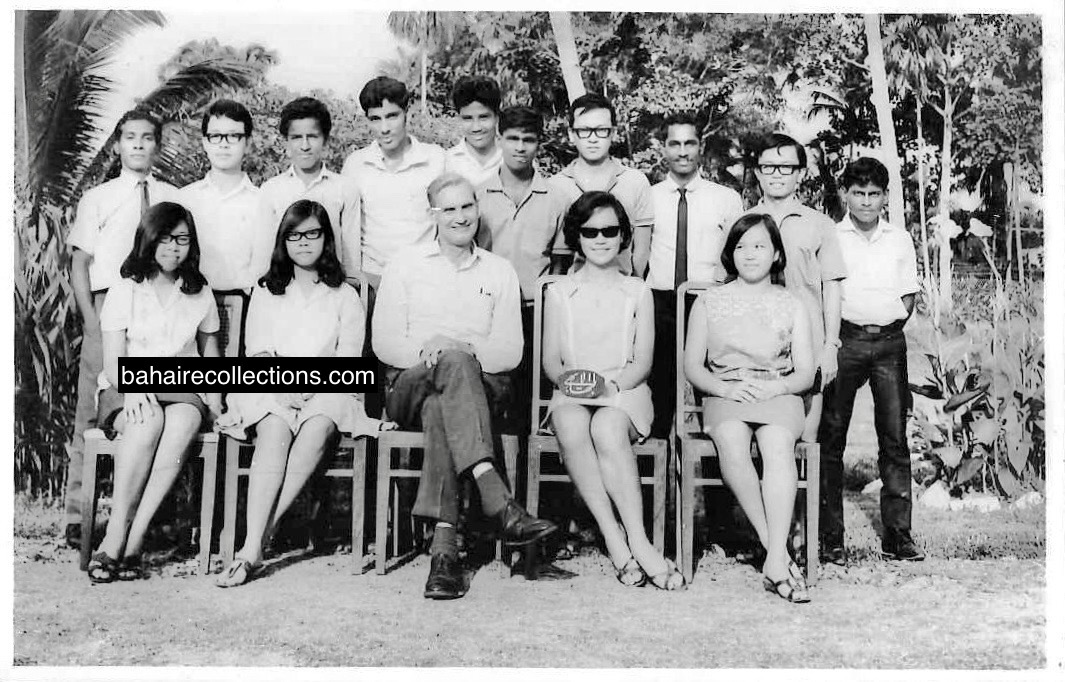
Some believers in the Bagan Serai community with a visiting American believer seated in the center, 1966. Standing at extreme left is Maniam, and N. Munusamy stands fourth from left
When the National Spiritual Assembly of Malaysia appointed the first Asli Teaching Committee in 1967, called the Aborigine Committee then, Maniam was a natural choice to be included in this committee.
TO SARAWAK FOR GOOD
Maniam attended the Intercontinental Conference held in New Delhi, India in October 1967, and was very moved by the talks by the three Hands of the Cause who were present- Dr. Muhájir, Mr. Abu’l-Qásim Faizi, Dr. ‘Alí-Muḥammad Varqá, and General Shu’á’u’lláh ‘Alá’í. This conference strengthened his resolve to rise to a higher level of service in the Cause. By this time Maniam’s unique services and commitment to teaching the natives of the interior of Sarawak were already well known to even international institutions. In 1967, three parties- the Universal House of Justice, Hand of the Cause of God Dr. Rahmatu’lláh Muhájir, and the National Teaching Committee of Malaysia urged Maniam to return to Sarawak as the vacuum created by him was yet to be adequately filled. Therefore in 1967 Maniam returned to Sarawak, and once again traveled into the interiors and became an undisputed worker for the Cause. When Maniam returned to Sarawak the domestic situation was more settled. Sarawak which fell under the National Spiritual Assembly of Malaysia was well guided in every way by the national institution. Dr. John Fozdar who had already moved from Sandakan into Sarawak was a beacon of guidance for the nascent community in Sarawak. Maniam had a wonderful working relationship with Dr. Fozdar and his wife Mrs. Grete Fozdar throughout his life. Their presence itself was a big strength for Maniam.
From the moment Maniam returned to Sarawak, he was clear in his mind never that he would never return to West Malaysia. He wanted his bones to be buried in the land where he had decided to pioneer. Maniam had grown under the loving shadow of saintly figures like Yankee Leong and Leong Tat Chee, and their guidance had been a great motivating force in his life, not to forget his meeting with Hands of the Cause of God. Maniam often quoted what Leong Tat Chee used to say, “A pioneer is one who buries his bones in the country where he pioneers.” Maniam was always on the move into the interiors of the state and when was back to Kuching he used to stay in the rented Bahá’í Centre.
Maniam once again proved to be a great asset in the field of teaching in Sarawak. The National Spiritual Assembly of Malaysia in its Feast Newsletter dated 21 March 1968 for the month of Bahá reported that Maniam had visited 15 villages and 5 were opened to the Faith with many declarations.
When a Bahá’í Teachers Training Course was conducted at the National Bahá’í institute in Malacca in September 1969, Maniam spoke on the topic of “My Experiences in Teaching the Faith in Sarawak.” His talk was well-received, with appreciation. Among the hundreds of people to whom Maniam gave the Faith was Ragai Lang. Ragai Lang went to visit his uncle who was a Bahá’í in Sungei Turong in the Samarahan District in 1970. That was the occasion where Grete Fozdar officially opened the Bahá’í Centre in Sungei Turong. As no translator was available Ragai Lang was called upon to translate for Grete Fozdar, after which she discussed the Faith with him. Maniam who was also at that event came visiting Ragai Lang on two occasions later and on his second visit presented Ragai Lang with the book Bahá’u’lláh and the New Era on behalf of the Bahá’í Teaching and Administrative Committee of Sarawak. Ragai then accepted the Faith.
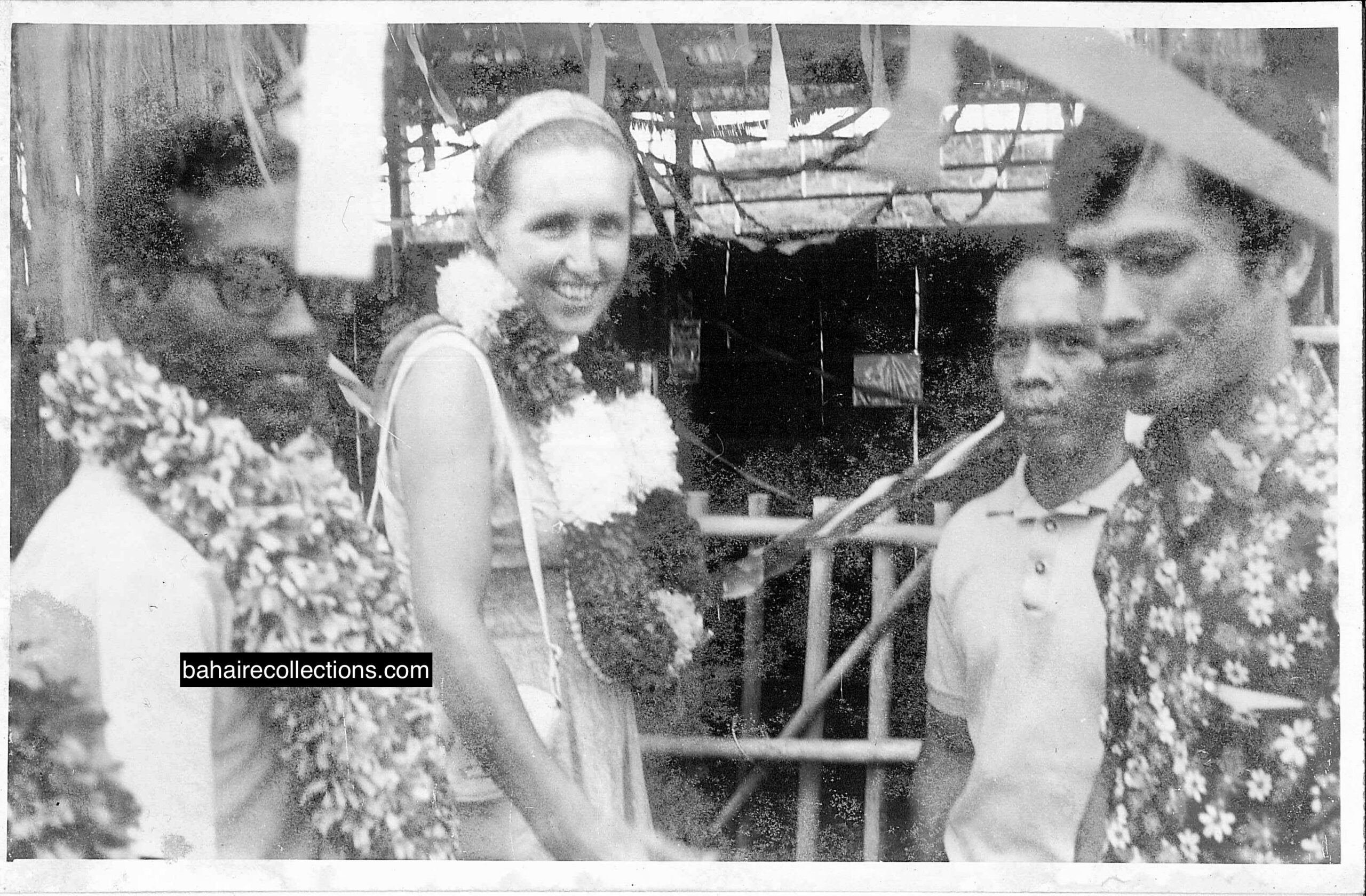
Maniam and Auxiliary Board member Mrs. Grete Fozdar at the official opening of a Bahá’í Centre at Sabal Aping, Second Division on 27 June 1972. The Bahá’í Centre was built by the people of Sabal Aping. More than 60 friends, including three members of the National Spiritual Assembly, participated in a day-long teaching conference

Maniam manning Bahá’í exhibition at the Annual Trade Fair in Kuching, circa 1972

Bahá’í Teachers Conference held at the Bahá’í Centre of Kuching in October 1973. Standing at the extreme right, from R-L Maniam, Ragai Lang, and G. Kuppusamy
Among the many well-remembered activities that Maniam initiated was one Inter-Youth Conference that Maniam organized in Kampong Triboh, Serian in the First Division of Sarawak on 24 and 25 December 1972, with the aim of promoting interaction and fellowship among the youths in Sarawak. A bus was chartered to gather friends from several spots and transport them to the conference venue.

Inter-Youth Conference in Kampong Triboh, Serian. L-R: Frankie Ang, Raymond Song, Peter Wang, Maniam, Upendra Ravi, Ragai Lang, Christine Chan, (Air Force man) Cecelia, (unknown) Judy Wee, Sapong Andar, Desmand Choo, Appalasamy, Howard Tsai, Wong Fook Yee, Elam ak Kanang
Having decided to root himself permanently in Sarawak, he started to look for a livelihood to be more independent. He had pioneered at a time when the situation was very difficult. Maniam started repairing radios, typewriters, and cars and then moved on to sell furniture. However, he still went through untold sufferings which he did not share widely with others. He was also an active insurance agent and ran an air ticketing agency as well. Later he had a gift shop in the army camp near the Kuching Airport.
Having decided to bury his bones, in Sarawak, he next decided to get married to a native of Sarawak. On 17 June 1975, Maniam married a local Iban believer Miss Nyamut Gelai, thus becoming the first believer of the Indian race of Tamil extraction from Malaysia to have married a native believer of Sarawak. This marriage further cemented his love and ties with the Iban race.
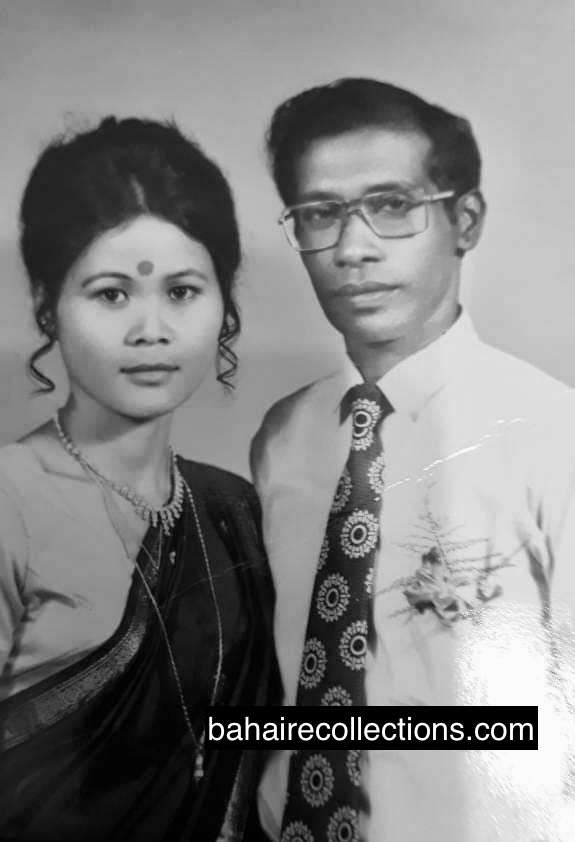
Nyamut and Maniam
The National Spiritual Assembly of Malaysia, comprising Peninsula Malaysia, Singapore, and the Borneo states of Sabah and Sarawak, with its seat in Kuala Lumpur was elected in 1964. In 1972 when a separate National Spiritual Assembly was elected for East Malaysia and Brunei, Maniam was elected to this national body and was reelected onto this body in the following year of 1973. Again in 1974 when the National Spiritual Assembly of East Malaysia and Brunei and the National Spiritual Assembly of West Malaysia were merged into the National Spiritual Assembly of Malaysia, Maniam was elected on this body and served for many years.

National Spiritual Assembly of East Malaysia and Brunei, 1972. Seated L-R: Choo Yeok Boon, Dr. John Fozdar, Rusi Irani and Maniam. Standing L-R: Ragai anak Lang, Thinathayallam, Lim Boon Huat, G. Kuppusamy and Sapong Andar

Winter School in Johor Baru, December 1974. Standing are members of the National Spiritual Assembly L-R: Maniam, Ganasa Murthy, Yin Hong Shuen, Isaac D’Cruz, S. Nagaratnam, Captain Choo Yeok Boon, Dr. Singaraveloo, Dr. John Fozdar, and Ragai Lang. Seated L-R: Auxiliary Board member Shantha Sundram, Counselor Dr. Chellie John Sundram, Counselor Yankee Leong, and Auxiliary Board member Inbum Chinniah
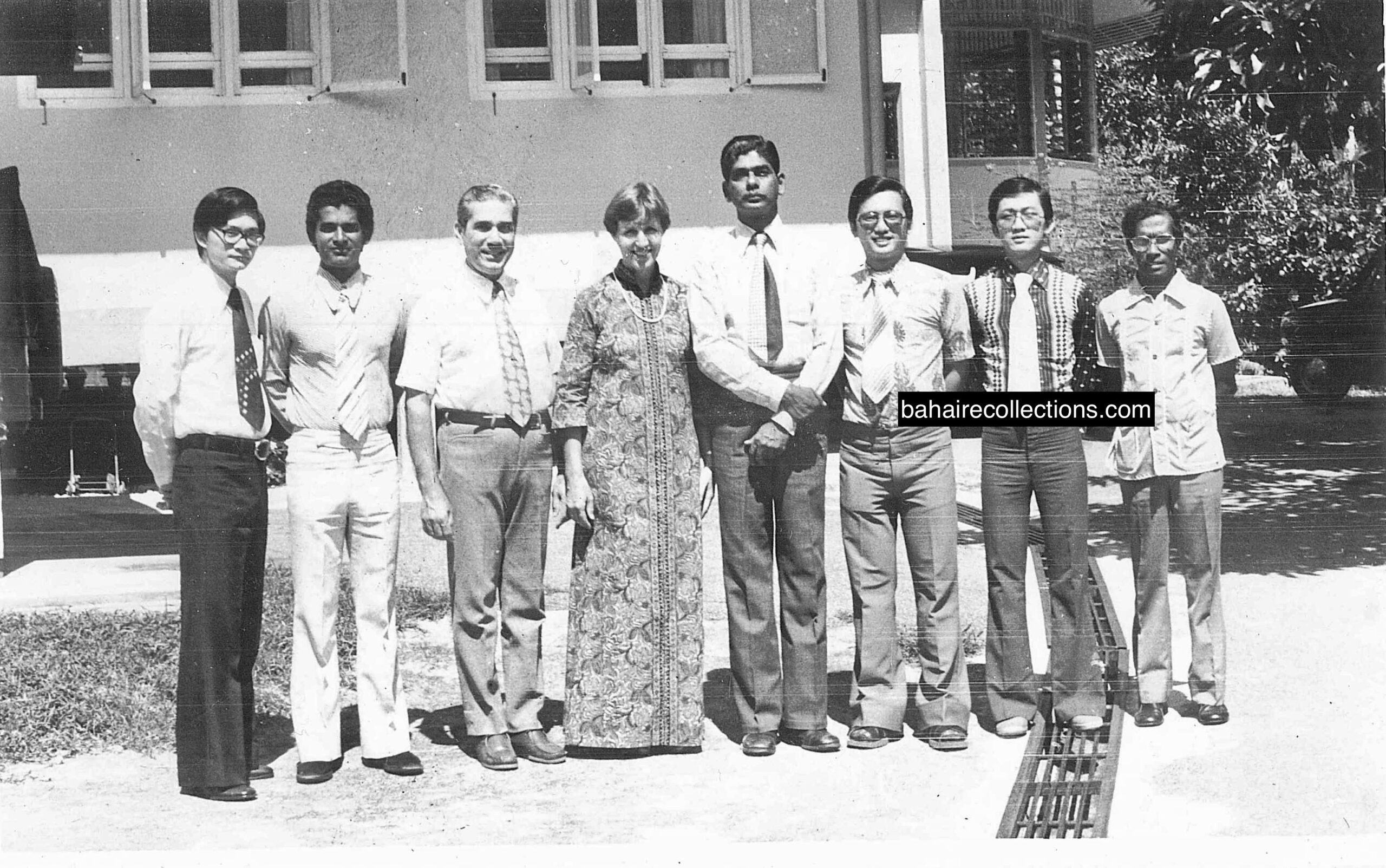
Meeting of the National Spiritual Assembly of Malaysia at the residence of the Fozdars in Kuching, 1979. L-R: Yin Hong Shuen, Isaac D’Cruz, Dr. John Fozdar, Mrs. Grete Fozdar, S. Nagaratnam, Lum Weng Chew, Lim Pun Huat, M. Maniam
Maniam also served on the Local Spiritual Assemblies in Sarawak, chiefly Kuching and Serian, and the National Teaching Committee of East Malaysia. He also served for one term on the first Regional Bahá’í Council of Sarawak for one year from 1991 to 1992.
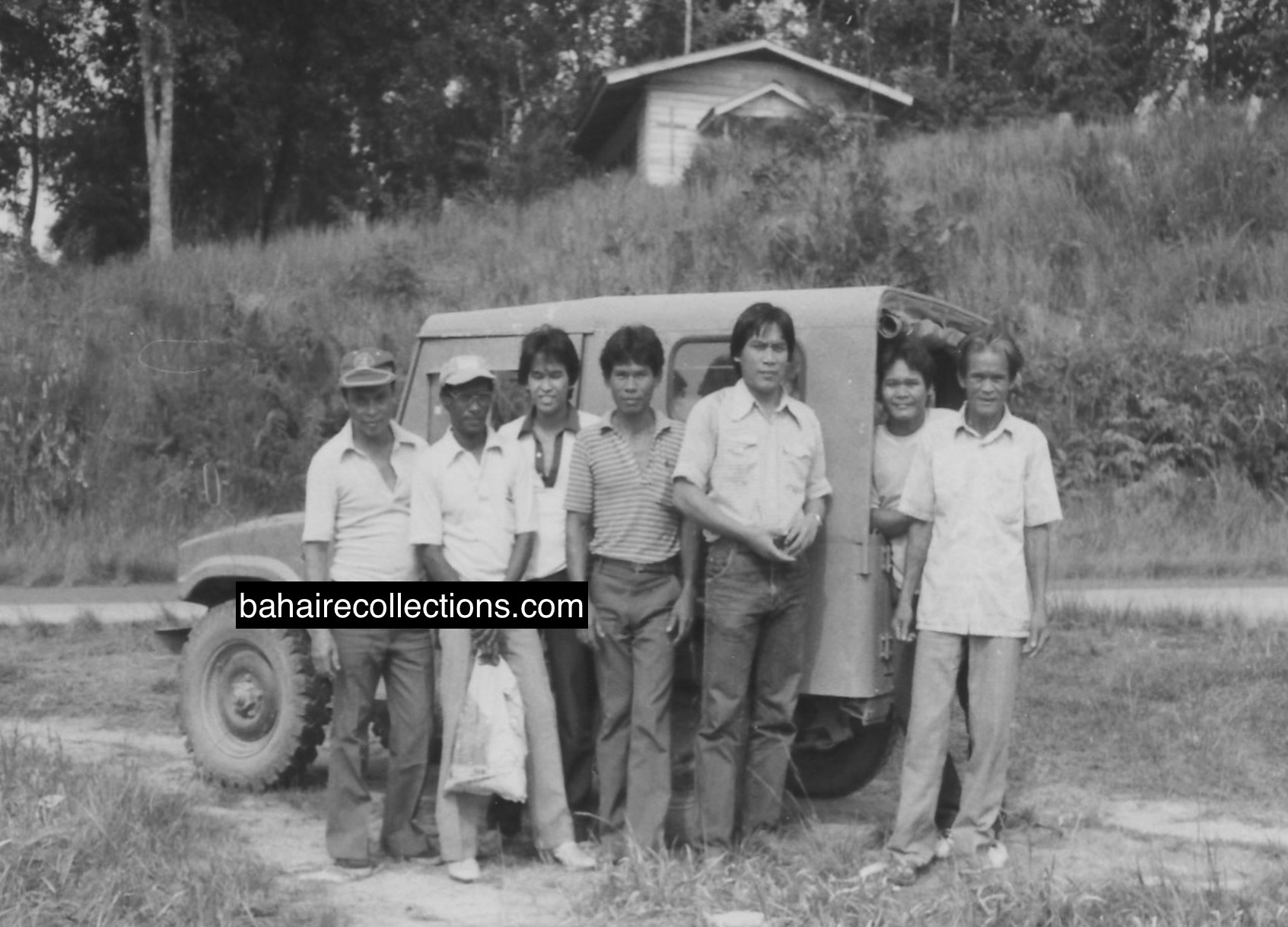
Teaching trip to Semukoi, Serian, 1983. L-R: Ragai Lang, Maniam, Jemeni Indin, Gunjus Mancha, Dajai Mancha, Lenyau Gelai and Umap
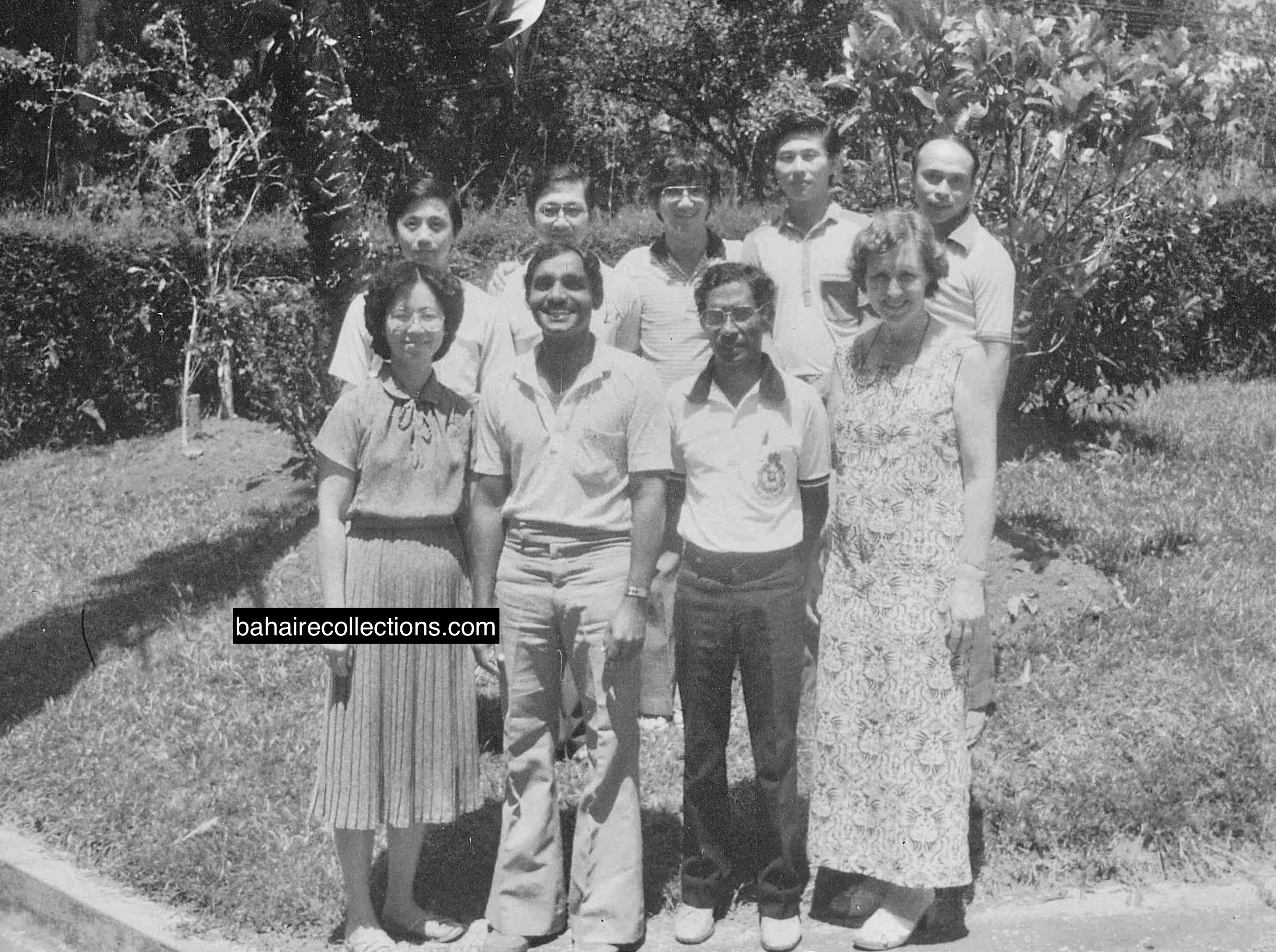
National Teaching Committee of East Malaysia for 1983. L-R: Miss Lai Kia Chin, Ramu Naidu, Maniam and Grete Fodar. Back Row L-R: Tay Yang Huang, Lim Pun Huat, Frankie Ang, Michael Soo and Ragai Lang
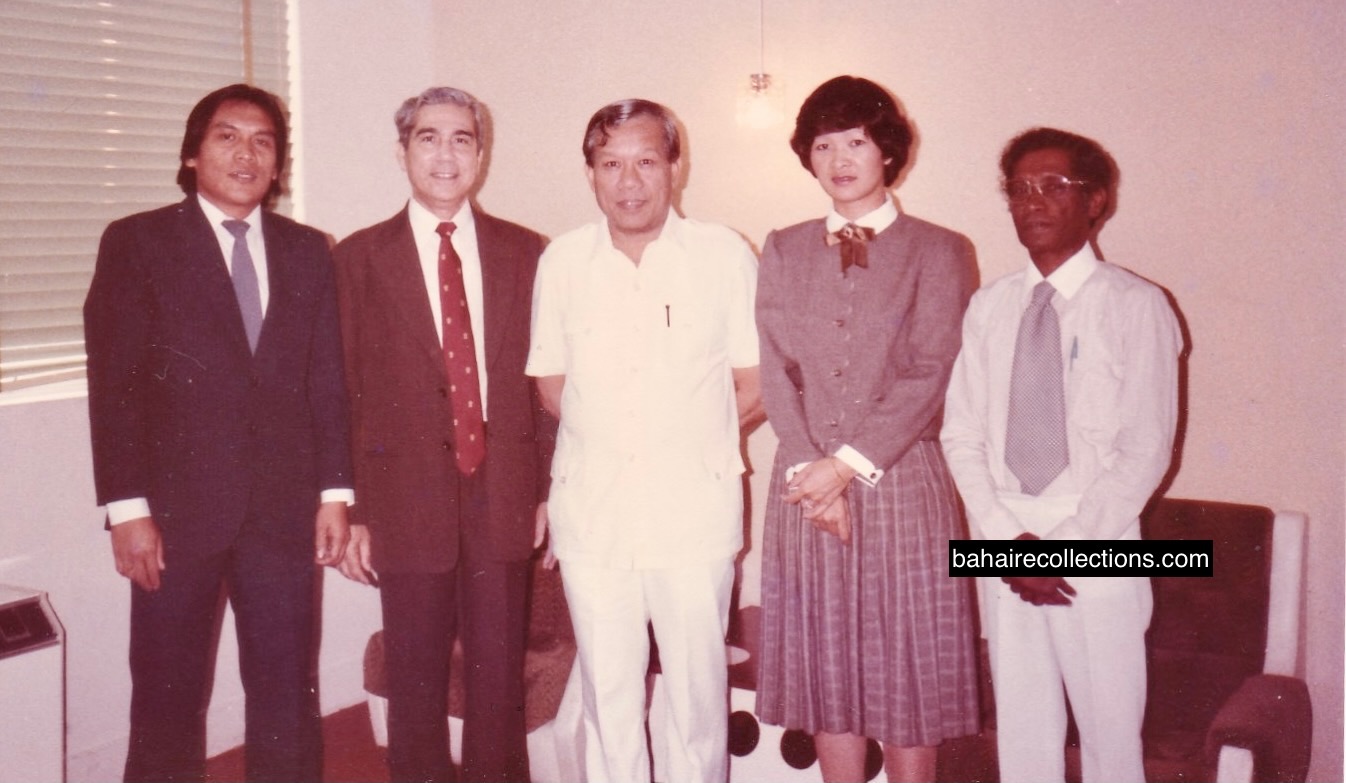
Courtesy call upon Federal Minister of Education, 1984. L-R: Dajai Mancha, Counselor Dr. John Fozdar, the Education Minister, Datuk Sulaiman Daud, Winnie Hee, and Maniam
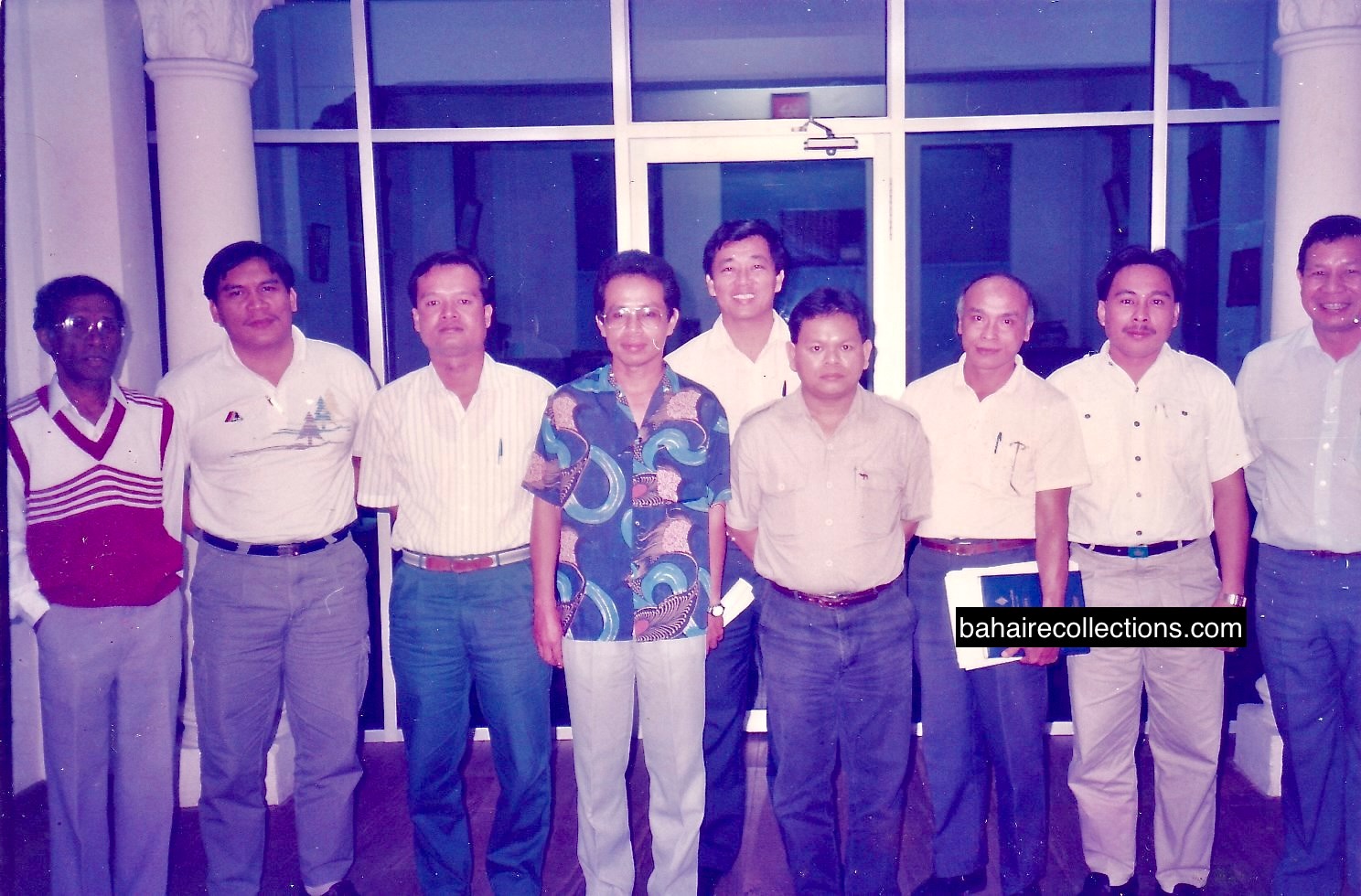
First State Bahá’í Coouncil of Sarawak, 1991. L-R: M. Maniam, Dajai Mancha, Suai Kirak, Narong Singau, Robert Ting, Salam Chimi, Ragai Lang, Tipik Ladi and Mcmillan Bau
Maniam had moved closely with many elders in the Faith and with many members of institutions. Maniam kept in touch with his old friends in Malacca and in each trip back to West Malaysia, he did not fail to call upon his close friends, among others, Kumara Das, Anthony Louis, and Jami Subramaniam.
Maniam and his wife did not have children of their own. As true lovers of humanity, Maniam and Nyamut consulted and adopted two girls and one boy from the relatives of Nyamut. Srimathy Maniam and Srinur Maniam are the girls, and Sri Purna Maniam the boy.
Towards the end of his life, Maniam became very ill, owing to various complications caused by diabetes and heart ailments. Having some premonition that his end of the earthly journey was near, Maniam started telephoning his relatives in West Malaysia and requested them to visit him before he was no more. Dr. Sri Ganesh who had served with Maniam on the National Spiritual Assembly for several years heard about his deteriorating health situation and flew down to Kuching in June 2008. He went through the medical reports, including the X-rays. He sadly informed Sri Mathi, daughter of Maniam that everything was now in the hands of God. Among the local friends who visited Maniam were Dr. John Fozdar and Mrs. Grete Fozdar. Within days Maniam succumbed to severe pneumonia. His health situation worsened when his lungs shrunk and caused breathing difficulties. On 10 July 2008, he was admitted into hospital and passed away at 1:59 pm the same day.
The passing of Maniam came as a big blow to his family, close friends, and relatives. One of the closest friends of Maniam who could not take the shocking news was admitted to the hospital. Many others could not come out of the trauma caused by this unexpected shock. Several friends came to pay last respect to a lovable friend, who had dedicated a full fifty years for relentlessly promoting the Cause of Bahá’u’lláh. Mr. Ragai Lang, his close friend, and co-worker placed accolades on Maniam at the funeral ceremony, organized by the Local Spiritual Assembly of the Bahá’ís of Kampong Triboh. Following a befitting burial ceremony, the earthly remains of Maniam were buried on the following day of 11 July at Kampung Triboh, Sarawak. He leaves behind his widowed wife and three children, and more than that fond memory and indelible track of his long and glorious services to the Cause in a land in which he had chosen to bury his bones.
Maniam shall always be remembered for his deep and unshakable commitment to teaching the natives of East Malaysia. He was one of the Bahá’ís of the Ten-Year Crusade period to have left the shores of West Malaysia for the then difficult Sarawak state. Maniam witnessed for himself the growth and steady development of the Faith shaping up right in front of his eyes during the more than four decades he lived there, with himself playing a significant role in that historical enterprise. Although Maniam was not a very highly successful businessman, he shone in-field teaching as a brilliant pioneer. He mastered the local Iban language and moved very closely with them, often spending many nights in the longhouses. It is said that there is no one longhouse that he had not visited in the interiors of Sarawak. He was often called the “backbone of Iban longhouse teaching”. He came to be loved very much for the very sincere love he himself showed them.
Maniam led a very simple and humble way of Bahá’í life, always radiating immense love through his broad and cheerful smile. His love for the Blessed Beauty and the Faith was beyond measure. Maniam practiced a good host to the early batch of travel teachers and pioneers from West Malaysia and abroad who visited Sarawak. A strong-minded person, Maniam’s constant advice to the younger Bahá’ís to live the Bahá’í way of life to be effective in the Cause and to attract others into the Faith. Maniam was always a very firm disciplinarian expecting a high standard of moral conduct and rectitude from the youth. He was very direct in advising them on Bahá’í matters. He always wanted tasks assigned to be carried out to the best. He drove home the cardinal point to the believers not to seek name, fame, or recognition and that one should serve the Cause only to earn the good pleasure of Bahá’u’lláh. What was important was for the names to be remembered by Bahá’u’lláh, not by the mortal beings. Deep inside Maniam was a very loving and caring person to those who knew him well. Throughout his life, Maniam had attempted to involve in business, where he had ups and downs, which forced him to live a simple life. Yet in service to the Cause, he was highly successful. Maniam, along with a few early workers of the Cause shall always remain household names in the history of the Faith in Sarawak.
Maniam’s long record of outstanding, unremitting, and highly meritorious services in Sarawak shall always remain unforgettable in the annals of the Faith. Rising generations of Bahá’ís will take immense pride in remembering him and emulating the spiritual path he had led and left.
A. Manisegaran
31 October 2021
Copyright@bahairecollections.com